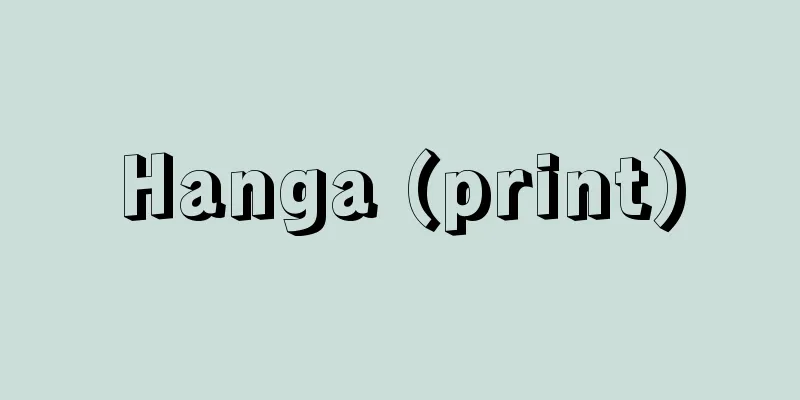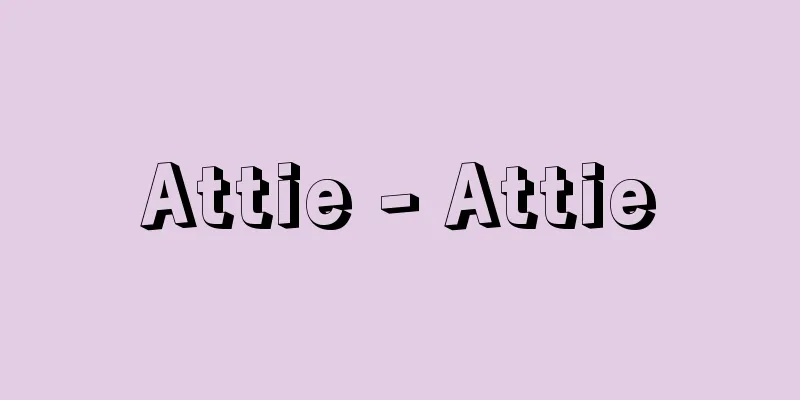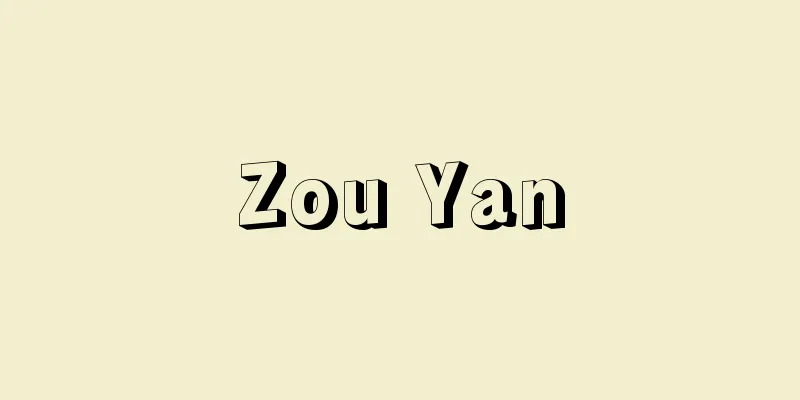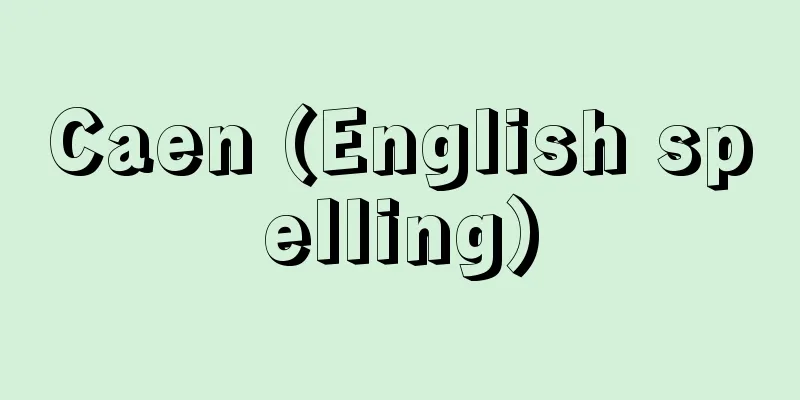Hanga (print)

|
A form of painting expressed indirectly by printing. Originally devised to obtain multiple copies of the same image, they are often produced for the texture and effect each technique produces, and there are also monotype prints (where a design is drawn with oil paint or ink on a glass, metal, or stone plate, and then paper is placed face down and printed over it) which can only be produced once. In recent years, many works have been produced that go beyond the traditional concept of printmaking, with extreme examples including those that use molds, footprints, fingerprints, and kiss marks. Prints are generally produced using printing materials such as woodblock prints, copperplate prints, and lithographs, but since anything can be used as a printing material, it is convenient to classify them into four types according to the printing format: letterpress, intaglio, planographic, and screen print. [Haruki Yaegashi] Types of printsLetterpress methodThis is the oldest printing method, in which the plate is carved out leaving only the lines and surfaces to be printed, and the raised areas are then coated with ink and printed on paper. There are woodblocks, metal cuts, woodblocks, linoleum cuts, etc. In the West, printing is done with a flatbed press, and in Japan it is done with a baren press. Frottage, in which ink is applied to leaves, cloth, wood grain boards, etc., and printed, can also be considered a letterpress method. [Haruki Yaegashi] IntaglioCopper plates, metal plates of similar quality (iron, steel, zinc), celluloid plates, etc., have a polished surface to make them easier to wipe off ink on. Images are engraved directly onto the plate using a burin or needle, or an image is drawn by scratching the anti-corrosive layer applied to the plate's surface with a needle, and then the plate is corroded with acid. Ink is applied to the plate and wiped off, and the ink remaining in the recesses (groups of lines or dots) is transferred to paper. [Haruki Yaegashi] LithographyUnlike woodblock and copperplate printing, which print an image through the unevenness of the plate surface, this method utilizes the repulsive properties of water and oil on a flat surface. This method is used in lithography, but today aluminum or zinc plates are sometimes used instead of stone plates. [Haruki Yaegashi] DyeingA print made by cutting an image into a cloth that is covered except for the part of the image to be printed, or by cutting the image into oil paper or tannin paper. This includes silkscreen (serigraphy), stencil, and kappa printing. [Haruki Yaegashi] History of PrintmakingThe birth of printmaking and the spread of paper are closely related. It is said that the method of making paper was introduced to Europe in the mid-12th century, but by the mid-14th century, paper was being produced in large quantities. Woodblock prints first appeared in Europe towards the end of the 14th century, followed by copperplate prints in the first half of the 15th century. Early woodblock prints had a strong populist feel and were used for things such as Bible subjects and holy icons as souvenirs for pilgrimages, amulets, game cards, and illustrations for books. In the second half of the 15th century, there was an improvement in technique, and from that time to the beginning of the 16th century, the German Renaissance master Dürer elevated woodblock printmaking to an extremely high level of art. Cranach the Elder and Altdorfer followed suit, but it fell into decline towards the end of the 16th century. Intaglio copperplate printing was invented somewhat accidentally in the field of metalworking, although it is not yet certain whether it was first made north or south of the Alps. The earliest dated copperplate print is from 1446. Metalcutting, in which images or decorative patterns were struck into soft metal plates such as tin with various chisels and then printed using the relief printing method, was developed in the metalworking field at the beginning of the 15th century, but fell out of use with the advent of copperplate printing. At the time, woodblock artists belonged to the carpenters' guild, while copperplate engravers belonged to the higher-ranking metalworkers' guild. From the very beginning, copperplate prints were often beautiful as artistic works, and were produced especially for the upper classes. Early copperplate prints were engravings, in which the image was directly carved into the print using a burin, a tool used in metalworking, but the pinnacle of artistic copperplate printmaking can be seen in the works of the German engraver E. S. (active around 1450-1467) and the Florentine "Precision Technique." In the second half of the 15th century, Italian painters Pollaiuolo and Mantegna, and Schongauer in the north, began to try their hand at engraving. It was Dürer who perfected copperplate printmaking as an elegant art that could compare favorably with painting. The first half of the 16th century was the period when engraving was at its peak, centered around Dürer. Representative copperplate engravers of this period include Cranach the Elder and Altdorfer in Germany, Lucas van Leyden (1489/1498-1533) in the Netherlands, and Marcantonio Raimondi (c. 1480/1482-c. 1524/1534) in Italy. Raimondi worked in collaboration with the painter Raphael, producing prints based on his sketches, a trend that became common during the Mannerist period in the second half of the 16th century. While engraving techniques also developed to a high level, they lost artistic originality and became a mere technique for reproducing paintings. Meanwhile, etching had already been attempted by Dürer and Altdorfer in the first half of the 16th century, but the right mixture of acids for etching copperplates had not yet been found. However, by the beginning of the 17th century, this problem had been solved, and Rembrandt of the Netherlands, who succeeded Hercules Segers, who had conducted many original experiments, made full use of the expressive possibilities of etching, leaving behind many masterpieces. Etching allows more freedom in drawing lines than engraving, is extremely quick to make, and even allows for improvisation, so many artists tried it, and it became the central technique of creative printmaking from the 17th century to the beginning of the 20th century. Representative etchers in the 17th century include Ostade, Jacques Callot, and Claude Lorrain, and in the 18th century, Piranesi, Tiepolo father and son, Canaletto, and Goya. Goya took advantage of the aquatint technique, which had only just been developed, to create dramatic light and dark expressions in his series such as "The Caprichos" and "The Aphorisms." Meanwhile, at the end of the 18th century, the English poet and amateur artist William Blake produced many excellent prints using ingenious methods, one of which was "The Book of Urizen," which was printed using relief printing on deep-etched copperplates. Towards the end of the 17th century, mezzotint was developed as a new method of dry copperplate printing. This became popular in 18th century England, but with the exception of Turner's series of "The Book of Study" in the first half of the 19th century, it was mainly used to reproduce paintings. In the 19th century, lithography, which could reproduce the effects of chalk and ink drawings almost exactly, became another method of creative printmaking, but etching continued to grow, producing unique and excellent works by artists such as Corot, Millet, Manet, Degas, Pissarro and Whistler. Mary Cassatt, an American woman who joined the Impressionist group, succeeded in imitating the effects of Japanese ukiyo-e prints using etching and polychrome aquatint. The German painter Max Klinger also produced many impressive series of etchings. The invention of lithography at the end of the 18th century can be said to have been a revolution in the history of printmaking. Goya and Delacroix were the first artists to use this method to produce highly artistic works. Daumier left behind as many as 4,000 lithographs, mainly caricatures. Impressionist painters such as Manet, Degas, and Renoir, as well as Rodolphe Bresdin (1822/1825-1885), Whistler, and Redon were also excellent lithographers. Multicolor lithography was developed towards the end of the 19th century, and Bonnard, Vuillard, and Lautrec made full use of it. At the end of the 19th century, woodcut prints were revived in creative life by Gauguin and Munch, and were continued by German Expressionist painters, particularly the "Brücke" (Bridge School) group including Kirchner and Haeckel. Almost every artist in the 20th century tried their hand at printmaking, each producing distinctive works, but perhaps the greatest printmaker was Picasso. He left behind over 2,000 works using almost every printmaking technique, but his original development of linoleum cuts is particularly noteworthy. Also, Ernst's attempt at frottage, the revival of mezzotint by Japanese artists such as Hasegawa Kiyoshi and Hamaguchi Yozo, and the popularity of silkscreen printing after World War II were noteworthy events in the history of printmaking technology. Woodblock printing was introduced to Japan from China during the Nara period (8th century), and was used to carve sutras and images in connection with Buddhist faith. From around the late Heian period (12th century), this technique was adapted for use as a preliminary sketch for Buddhist paintings and narrative pictures, and for decorating paper, becoming an important artistic tool. Then, from the late 17th century during the Edo period, it developed rapidly with the popularity of ukiyo-e prints. Copperplate printing was introduced to Japan with the introduction of Christianity in the late 16th century, and the first artist to try it was Shiba Kokan. [Haruki Yaegashi] "World Prints from the Paris National Library, edited and annotated by J. Adhemar and Mitsuru Sakamoto, 16 volumes in total (1978-1979, Chikuma Shobo)" ▽ "Encyclopedia of Prints, by Tetsuro Murofushi (1985, Tokyo Shoseki) " ▽ "History and Collections of Prints: From Dürer and Rembrandt to Picasso, by F. Salamon, translated by Akira Nakagawa (1976, Sansai Shinsha)" ▽ "Prints, by J. Adhemar et al., translated by Reiga Koda (Hakusuisha Bunko Quessais-je)" [References] | | | | | | |1551 Woodblock print (Metropolitan Museum of Art ) Cranach's "Martin Luther" Circa 1470 Copperplate print Paris Museum Antonio Pollaiuolo: "The Nudes" 1622 Copperplate print ( Chicago Art Institute ) Caro's "The Market at Impruneta" 1890-1891 Copperplate print, owned by the Art Institute of Chicago Cassatt's "Mother's Embrace" 1834 Lithograph ( Collection of the Metropolitan Museum of Art ) Daumier's "The Rue Transnonant, 1834" 1879 Lithograph ( Collection of the Art Institute of Chicago ) Redon: Visions in a Dream 1891 Lithograph ( Collection of the Art Institute of Chicago ) Toulouse-Lautrec's "Moulin Rouge, La..." 1893-1894 Woodblock print, Metropolitan Museum of Art Gauguin's "Noah Noah" Source: Shogakukan Encyclopedia Nipponica About Encyclopedia Nipponica Information | Legend |
|
印刷という間接的方法で表現する絵画の形式。本来は同一画像を複数得るためにくふうされたものだが、それぞれの技法の生み出す質感や効果のために制作されることも多く、また1点しか作品のできないモノタイプ版画monotype(油絵の具やインキでガラス板、金属板、石の板に図柄を描き、それに紙を伏せて刷り取ったもの)もある。近年は従来の版画の概念を超えた作品も多く生み出されており、その極端な例としては、鋳型を用いたものや、足跡、指紋、キス・マークによるものなどがある。版画は一般に木版画、銅版画、石版画のように版材によって記述されるが、あらゆるものが版材になりうるので、印刷形式によって凸版、凹版、平版、孔版の4種に分類するのが便利である。 [八重樫春樹] 版画の種類凸版法もっとも古い版画の方法で、刷り出したい線や面を残して版面を彫り下げ、凸部にインキを塗って紙に刷る方法。木版、メタルカット、木口(こぐち)木版、リノリウム・カットなどがある。西洋では平圧印刷機で刷り出し、日本では馬連(ばれん)などで刷る。木の葉、布、木目のある板などにインキを塗って刷るフロッタージュも凸版法とみることができる。 [八重樫春樹] 凹版法銅板およびそれに準ずる金属板(鉄、鋼鉄、亜鉛)、セルロイド板などの表面を磨いてインキを拭(ふ)き取りやすくした版材に、ビュラン、針などで直接画像を刻むか、あるいはその表面に施した防食層を針で掻(か)き削るようにして画像を描き、これを酸で腐食する。この版にインキを塗って拭き取り、凹部(線、点の集まり)に残ったインキを紙に転写させる。 [八重樫春樹] 平版法木版画や銅版画のように板面の凹凸を介して画像を刷り出すのではなく、平面上で水と油の反発しあう性質を利用した方法。石版画(リトグラフ)がこの方法によるが、今日では石板のかわりにアルミ板や亜鉛板を用いることもある。 [八重樫春樹] 孔版法刷り出す画像の部分を除いて目をふさいだ布、画像を切り抜いた油紙や渋紙を通して制作する版画。シルクスクリーン(セリグラフィ)、ステンシル、合羽(かっぱ)版などがこれに属する。 [八重樫春樹] 版画の歴史版画の誕生と紙の普及は深い関係にある。紙の製法がヨーロッパに伝えられたのは12世紀なかばとされるが、14世紀なかばまでには紙はかなり大量に生産されるようになっていたようである。ヨーロッパにおける版画は、まず14世紀の末ごろに木版画が出現し、ついで15世紀前半に銅版画が生まれた。初期の木版画は民衆芸術的な色彩が強く、聖地巡礼の記念品としての聖書の題材や聖像を表したもの、護符、ゲーム・カード、書物の挿絵などに用いられた。15世紀後半になると技術的向上がみられ、同期から16世紀初めにかけてドイツ・ルネサンスの巨匠デューラーが木版画をきわめて高い芸術の次元に引き上げた。クラナハ(父)、アルトドルファーらがこれを受け継いだが、16世紀の末ごろには衰退してしまった。 凹版法による銅版画は、金工の領域からやや偶然に発明されたが、アルプスの北側と南側のどちらが先かはまだ確認されていない。もっとも早い年記のある銅版画は1446年のものである。金工師の技術領域からは、15世紀の初めに錫(すず)などの軟質の金属板にさまざまの鏨(たがね)で図像や装飾模様を打ち表し、凸版法で刷るメタルカットが生まれたが、銅版画の登場とともに廃れた。当時、木版画師は大工のギルドに属し、銅版画師はそれよりも地位の高い金工師のギルドに属した。 銅版画はごく初期から工芸的な美しさをもつものが多く、とりわけ上流階級を対象に制作された。初期の銅版画は、金工の道具の一つであるビュランで直接画像を彫るエングレービングであったが、ドイツのE(イー)・S(エス)の版画家(1450~1467年ごろ活躍)の作品や、フィレンツェの「精密技法」に、工芸的銅版画の粋をみることができる。15世紀後半には、イタリアのポライウオーロやマンテーニャ、北方ではションガウアーらの画家たちがエングレービングに手を染めるようになった。そして、銅版画の分野でも、これを絵画などに比べて遜色(そんしょく)のない格調高い芸術として完成させたのは、デューラーであった。16世紀前半はデューラーを中心に、エングレービングがもっとも隆盛を迎えた時代である。ドイツではクラナハ(父)、アルトドルファーら、オランダのルーカス・ファン・ライデンLucas van Leyden(1489/1498―1533)、イタリアのマルカントニオ・ライモンディMarcantonio Raimondi(1480/1482年頃―1524/1534年頃)らが、この時期の代表的銅版画家である。ライモンディは画家のラファエッロと提携してその下絵による版画を制作したが、こうした傾向は16世紀後半のマニエリスムの時代には一般的になる。エングレービングの技術も高度な発達を遂げた反面、芸術的独創性を失って絵画の複製のための技巧に堕した。 一方、エッチングは16世紀前半にすでにデューラーやアルトドルファーらによって試みられていたが、銅版の腐食に適切な酸の調合がまだみいだされていなかった。しかし、17世紀に入るまでにこの問題も解決され、とくに独創的な実験を重ねたヘルクレス・セーヘルスの後を継いだオランダのレンブラントは、エッチングの表現技術上の可能性を余すところなく活用し、数多くの名作を残した。エッチングはエングレービングに比べて線も自由に描けるうえに製版が著しく早く、即興的な制作さえ可能なので多くの画家たちが試み、17世紀から20世紀初めにかけての創作的版画の中心的技法となった。代表的なエッチャーとしては、17世紀はレンブラントのほかにオスターデ、ジャック・カロ、クロード・ロラン、18世紀ではピラネージ、ティエポロ父子、カナレット、ゴヤらがあげられる。ゴヤは、開発されてまもないアクアチントの技法を利して、『ロス・カプリーチョス』『格言』などの連作で劇的な明暗表現を生んだ。 一方、18世紀末にイギリスの詩人で素人(しろうと)画家のウィリアム・ブレイクが独創的な方法で数々の優れた版画を生んだが、その一つにディープ・エッチングの銅板を凸版刷りにした『ウリゼンの書』がある。17世紀の末ごろに乾式銅版画の新しい方法としてメゾチントが開発された。これは18世紀のイギリスで流行したが、19世紀前半のターナーによる『研鑽(けんさん)の書』の連作を除けば、おおむね絵画を複製するために用いられた。 19世紀に入ると、チョークやインキの素描の効果をほぼそのまま再現できるリトグラフの方法が画家たちに好まれ、創作版画のもう一つの方法となったが、エッチングも衰えず、コロー、ミレー、マネ、ドガ、ピサロ、ホイッスラーらの画家たちによって個性のある優れた作品がつくられた。アメリカ出身で印象派のグループに加わった女流画家のメアリー・カサットは、日本の浮世絵の効果をエッチングと多色アクアチントで模倣することに成功している。ドイツの画家マックス・クリンガーも感銘深いエッチングの連作を多数生んだ。 18世紀末のリトグラフの発明は版画史上の革命であったといえる。ゴヤとドラクロワは、この方法によって芸術性の高い作品を生んだ最初の画家であった。ドーミエは風刺画を中心に4000点ものリトグラフを残している。マネ、ドガ、ルノワールらの印象派の画家たちをはじめ、ブレダンRodolphe Bresdin(1822/1825―1885)、ホイッスラー、ルドンも優れたリトグラフの版画家であった。19世紀末ごろには多色刷りリトグラフが開発され、ボナール、ビュイヤール、ロートレックらがこれを十分に活用した。 19世紀末、ゴーギャンとムンクによって木版画の創造的生命が復活され、ドイツ表現主義の画家たち、とりわけキルヒナー、ヘッケルらの「ブリュッケ」(橋派)のグループに受け継がれた。 20世紀にはほとんどすべての画家が版画を試み、それぞれ特色のある作品を生み出しているが、最大の版画家はピカソであろう。彼はほぼあらゆる版画の技法を駆使して2000点余の作品を残したが、独創的なリノリウム・カットの開発は特筆に値する。また、エルンストらのフロッタージュの試み、長谷川潔(はせがわきよし)、浜口陽三(ようぞう)ら日本人によるメゾチントの復活、そして第二次世界大戦後におけるシルクスクリーンの流行は、版画技術史上注目すべきできごとであった。 日本では奈良時代(8世紀)に木版画が中国から伝来し、仏教信仰と関連して経文や図像などが彫られた。この技法は平安時代後期(12世紀)ごろから仏画や物語絵の下絵や料紙の装飾などに転用され、重要な美術的手段となった。そして、江戸時代の17世紀後期以降、浮世絵版画の流行に伴い急速な発達を遂げた。銅版画は16世紀後半にキリスト教伝来とともに渡来したが、これを試みた最初の画家は司馬江漢(しばこうかん)であった。 [八重樫春樹] 『J・アデマール、坂本満編・解説『パリ国立図書館版 世界版画』全16巻(1978~1979・筑摩書房)』▽『室伏哲郎著『版画事典』(1985・東京書籍)』▽『F・サラモン著、中川晃訳『版画の歴史とコレクション――デューラー、レンブラントからピカソまで』(1976・三彩新社)』▽『J・アデマール他著、幸田礼雅訳『版画』(白水社文庫クセジュ)』 [参照項目] | | | | | | |1551年 木版画メトロポリタン美術館所蔵"> クラナハ『マルティン・ルター』 1470年ころ 銅版画ParisMusées"> アントニオ・ポライウオーロ『裸人たちの… 1622年 銅版画シカゴ美術研究所所蔵"> カロ『インプルネタの市』 1890~1891年 銅版画シカゴ美術研究所所蔵"> カサット『母の抱擁』 1834年 リトグラフメトロポリタン美術館所蔵"> ドーミエ『トランスノナン街 1834年… 1879年 リトグラフシカゴ美術研究所所蔵"> ルドン『夢の中で 幻視』 1891年 リトグラフシカゴ美術研究所所蔵"> ロートレック『ムーラン・ルージュ、ラ・… 1893~1894年 木版画メトロポリタン美術館所蔵"> ゴーギャン『ノア・ノア』 出典 小学館 日本大百科全書(ニッポニカ)日本大百科全書(ニッポニカ)について 情報 | 凡例 |
Recommend
Okinawa Return - Okinawahenkan
Okinawa, which came under the rule of the United S...
European Union - oushuurengo (English spelling) European Union
The European Integration Organization was reconsti...
Amphiuma tridactylum (English name) Amphiumatridactylum
… [Takahiro Matsui]. … *Some of the terminology t...
appropriate technology
…an abbreviation for “alternative technology” or ...
Yato
It means a valley or marshland. It is a word that ...
Mannesmann [company] - Mannesmann
A major German integrated steel manufacturer known...
China tree - China tree
A deciduous tall tree of the Meliaceae family (AP...
Beijing
The capital of China. A directly-controlled munic...
Russian Owtscharka (English spelling)
…This dog is not as old as its name suggests, bei...
Throwing a pot - Touko
Also known as "tsubouchi." A game in whi...
Giant snake shell (Serpulorbis imbricatus)
As its name suggests, the shell coils up like a sn...
Faith - Kyoushin
Year of death: 866 Year of birth: Unknown A nembut...
Akatsuki Department
…Between summer and winter there is a special per...
A virtuous person
〘Name〙 = Utokujin (virtuous person) *Kanmon Goki -...
Daido
A prefecture-level city in the northern part of S...









